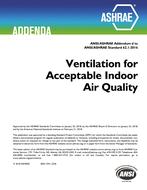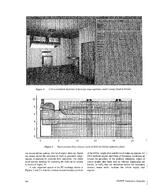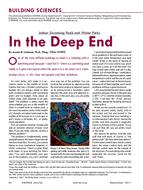Heat transfer and fluid flow in a horizontal-tube ammonia spray evaporator was investigated. The objectives of the research are (a) to conduct a thorough literature survey on horizontal-tube spray-film evaporators using nozzles, especially for the applications of airconditioning and refrigeration, (b) to perform horizontal spray evaporation experiments on plain and enhanced single tube and bundles using ammonia at different temperatures and flow conditions in order to identify the optimum operating conditions, (d) to develop correlations and charts for the design engineers. A detailed experimental investigation on the heat transfer and fluid flow of horizontal-tube ammonia spray-film evaporator were conducted. The experimental facility features a synthesis of an ammonia vapor-compression cycle with a spray evaporator, a liquid ammonia loop, and a water/ethylene glycol loop. The ammonia vapor generated in the spray evaporator is conducted to go through a vapor compression refrigeration cycle. The evaporator tube or tube bundle was heated by tube-side water/ethylene glycol mixture. Two types of tube were tested: plain tube, and low-fin tube. Both tubes were tested as a single tube, a 3 x 3 square-pitch tube bundle, and a 3-2-3 triangular-pitch tube bundle. Both pool boiling and spray evaporation tests were performed. Commercial standard-angle and wide-angle spray nozzles were used to distribute liquid ammonia on the tube or tube bundle during spray evaporation tests. Saturation temperature test range was from -10°F (-23°C) to 50°F (10°C), with corresponding pressure varying from 23.74 to 89.19 psia (164 to 615 kPa). Heat transfer coefficient data were collected within the heat flux range from 1,000 to 10,000 Btu/hr-ft2 (3.15 to 31.5 kW/m2) or higher. The experimental data were compared with the available falling film and pool boiling data. The effects of heat flux, saturation temperature, spray flow rate, nozzle height, and nozzle type were investigated. Correlations were developed for design engineers’ use. Result of a few tests with single corrugated tube are also presented.
An analysis of spray flow rates from nozzles reaching horizontal tubes at different locations below is presented. Such flow rates dominate the heat transfer performance of a device including spray nozzles and tube bundle. The flow rates are predicted based on given total nozzle flow rate, nozzle height, nozzle interval, spray angle, tube diameter, and the horizontal distance between the tube and the nozzles. The result is applicable to single row as well as array nozzle arrangement. Both round and square full-cone nozzles were considered. The analysis compares favorably with the nozzle-sprayed ammonia and water flow rate experimental results. All the data and correlations presented in this work are based on the spray flow rates determined by this analysis.
Product Details
- Published:
- 1995
- Number of Pages:
- 357
- File Size:
- 1 file , 5.1 MB
- Product Code(s):
- D-RP-725


